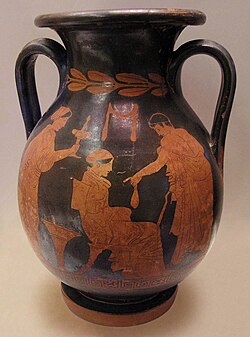
Back الدعارة في اليونان القديم Arabic Prostitució a l'antiga Grècia Catalan Πορνεία στην αρχαία Ελλάδα Greek Prostitución en la Antigua Grecia Spanish روسپیگری در یونان باستان Persian Prostituutio antiikin Kreikassa Finnish Prostitution dans la Grèce antique French זנות ביוון העתיקה HE Prostitucija u staroj Grčkoj Croatian Pelacuran di Yunani kuno ID
This article has multiple issues. Please help improve it or discuss these issues on the talk page. (Learn how and when to remove these messages)
|

Prostitution was a common aspect of ancient Greece.[note 1] In the more important cities, and particularly the many ports, it employed a significant number of people and represented a notable part of economic activity. It was far from being clandestine; cities did not condemn brothels, but rather only instituted regulations on them.
In Athens, the legendary lawmaker Solon is credited with having created state brothels with regulated prices. Prostitution involved both sexes differently; women of all ages and young men were prostitutes, for a predominantly male clientele.
Simultaneously, extramarital relations with a free woman were severely dealt with. In the case of adultery, the cuckold had the legal right to kill the offender if caught in the act; the same went for rape. Female adulterers, and by extension prostitutes, were forbidden to marry or take part in public ceremonies.[1]
Cite error: There are <ref group=note> tags on this page, but the references will not show without a {{reflist|group=note}} template (see the help page).
- ^ "WLGR". www.stoa.org. Archived from the original on 6 August 2018. Retrieved 4 August 2011.